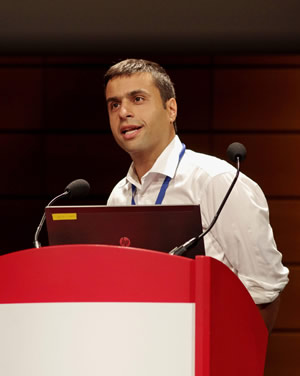By Olivia S. Rissland
Posted: May 15, 2018
 For nearly two decades, Dr. Hashim Murtadha Al-Hashimi has been the vanguard for studying RNA dynamics. He received a Bachelor of Science in Chemistry from Imperial College London and then pursued his Ph.D. at Yale University with Dr. James Prestegard, where he studied protein dynamics using NMR. As a post-doctoral fellow with Dr. Dinshaw Patel (Memorial Sloan-Kettering Institute), Dr. Al-Hashimi applied his NMR expertise to investigate RNA dynamics—a scientific passion that continues to shape his career. He started his own lab at the University of Michigan in 2002 and was then recruited to Duke University in 2014. He is currently the James B. Duke Professor of Biochemistry and the Director of the Duke Center for RNA Biology.
For nearly two decades, Dr. Hashim Murtadha Al-Hashimi has been the vanguard for studying RNA dynamics. He received a Bachelor of Science in Chemistry from Imperial College London and then pursued his Ph.D. at Yale University with Dr. James Prestegard, where he studied protein dynamics using NMR. As a post-doctoral fellow with Dr. Dinshaw Patel (Memorial Sloan-Kettering Institute), Dr. Al-Hashimi applied his NMR expertise to investigate RNA dynamics—a scientific passion that continues to shape his career. He started his own lab at the University of Michigan in 2002 and was then recruited to Duke University in 2014. He is currently the James B. Duke Professor of Biochemistry and the Director of the Duke Center for RNA Biology.
An independent undergraduate research project made him first think about “the plasticity of biomolecules.” He said, “I associated life with dynamics so strongly that I felt the structures of biomolecules would likewise also have to breathe to function. Within my first year of graduate school I was totally hooked on this problem.” During his post-doc search, Dr. Al-Hashimi began to consider the question of nucleic acid, rather than protein, dynamics. Although he worried about leaving the well-mapped familiarity of the protein world for wild unknowns of the RNA world, his graduate advisor prodded him past his hesitations: “There are few NMR scientists studying RNA so why not try something different?”
Dr. Al-Hashimi has always been guided by an ethos to “find and follow your passion—everything else will fall into place.” Even before starting post-graduate research, he was convinced that “dynamics would factor even more prominently for RNA than proteins because RNA is an even more flexible biopolymer.” He added that he thought “the motions would be larger in amplitude and therefore easier to detect and characterize experimentally. So it was the dynamics that drew me to RNA, and I would not have pursued a career in RNA science had it not been for Dinshaw.” His intuition was incisive, and when the data showed the “incredible flexibility” of the RNA he was studying, “it was exhilarating.”
“I associated life with dynamics so strongly that I felt the structures of biomolecules would likewise also have to breathe to function”
Even today, however, much about RNA folding and biology remains a mystery, and Dr. Al-Hashimi believes that “dynamics is the missing puzzle piece.” As he put it, “we know that RNA structures have to be dynamic to properly function, but dynamics has been, for many years, a fuzzy concept.” Because most biophysical techniques lack sufficient spatial and temporal resolution, sharpening this concept of RNA dynamics has been a major challenge for Dr. Al-Hashimi. Recent technical advances, however, are now putting dynamics on “a quantitative footing, and the future impact of these developments on the field will be enormous. Aside from getting to know RNAs at a deeper level, these developments are already enabling the design of new RNA targeting ligands in drug discovery applications.”
A recurring theme in his career is a deep appreciation for the scientists he has worked with. “I have been quite fortunate to have excellent trainees, colleagues, and collaborators, and to work in highly supportive environments,” he said, adding that “the best part of the job is seeing former trainees, now in independent careers, make significant contributions.” This camaraderie has made “the challenges we all face in academia a lot easier.”
Fittingly, when asked about his favorite RNA society memory, he said that, when he was an assistant professor, he “attended a party at Gabrielle Varani’s home at the 2006 RNA Society meeting in Seattle, and I got to meet Eric Westhof for the very first time.” He added, “The party ran late!”
Dr. Al-Hashimi’s favorite RNA is the HIV transactivation response element (TAR)—“there isn’t a close second.” He is not on social media, but you can enjoy his lab’s RNA movies at https://sites.duke.edu/alhashimilab/movies/.
